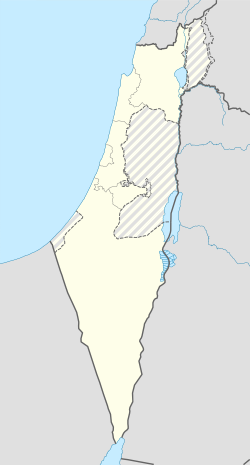
Back عقرون Arabic Ecron Catalan Tel Miqne CEB Ekron German Ακκαρών Greek Ekron Esperanto Ecrón Spanish Ekron Estonian Ekron Basque Éqron French
This article's lead section may be too short to adequately summarize the key points. (September 2021) |
עקרון عقرون | |
 | |
| Alternative name | Tel Miqne/Mikne (Hebrew), Khirbet el-Muqanna (Arabic) |
|---|---|
| Location | Israel |
| Region | Levant, Israeli coastal plain |
| Coordinates | 31°46′44″N 34°51′00″E / 31.778890°N 34.8499203°E |
| History | |
| Periods | Chalcolithic - Iron Age |
| Cultures | Canaanite, Philistine, Israelite |
| Site notes | |
| Archaeologists | Trude Dothan and Seymour Gitin |
Ekron (Philistine: 𐤏𐤒𐤓𐤍 *ʿAqārān,[1] Hebrew: עֶקְרוֹן, romanized: ʿEqrōn, Arabic: عقرون), in the Hellenistic period known as Accaron (Ancient Greek: Ακκαρων, romanized: Akkarōn)[2][3] was at first a Canaanite, and later more famously a Philistine city, one of the five cities of the Philistine Pentapolis, located in present-day Israel.
In 1957, Ekron was first identified with the mound of Khirbet el-Muqanna (Arabic) or Tel Miqne (Hebrew), near the depopulated Palestinian village of 'Aqir, on the basis of the large size of the Iron Age archaeological remains;[4][5] the judgement was strengthened by the discovery in 1996 of the Ekron inscription.[6] The tell lies 35 kilometres (22 mi) west of Jerusalem, and 18 kilometres (11 mi) north of Tel es-Safi, the almost certain site of the Philistine city of Gath, on the grounds of Kibbutz Revadim on the eastern edge of the Israeli coastal plain. The other main cities of the Philistine Pentapolis beyond Ekron and Gath were Gaza, Ashkelon, and Ashdod.
- ^ Ahituv, Shmuel (2008). Echoes from the Past: Hebrew and Cognate Inscriptions from the Biblical Period. Carta. pp. 338–9. ISBN 978-965-220-708-1.
- ^ 1 Maccabees 10:89
- ^ Accaron, at Bible Study Tools
- ^ Naveh, J. (1958). "Khirbat al-Muqanna'—Ekron: An Archaeological Survey". Israel Exploration Journal. 8 (2): 87–100. JSTOR 27924729.
- ^ NAVEH, J. (1958). "Khirbat al-Muqanna'—Ekron: An Archaeological Survey". Israel Exploration Journal. 8 (3): 165–170. JSTOR 27924741.
- ^ Cite error: The named reference
DoNa97was invoked but never defined (see the help page).
